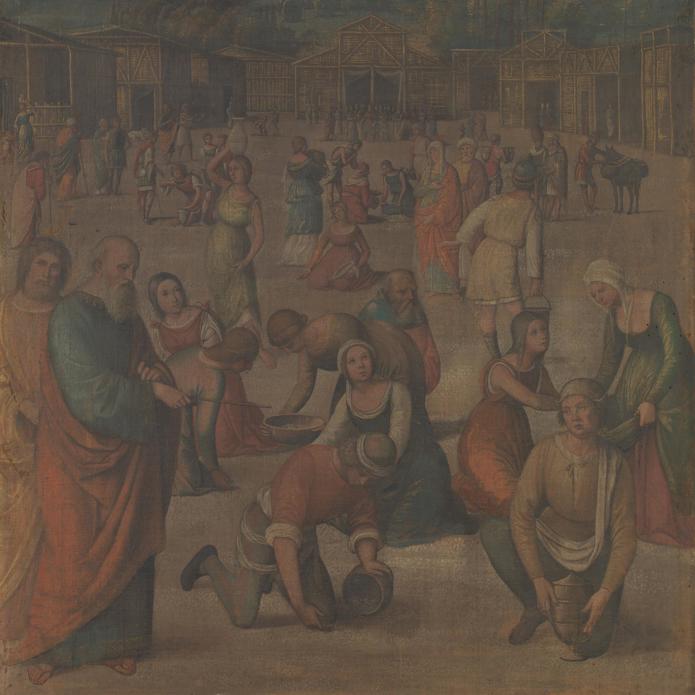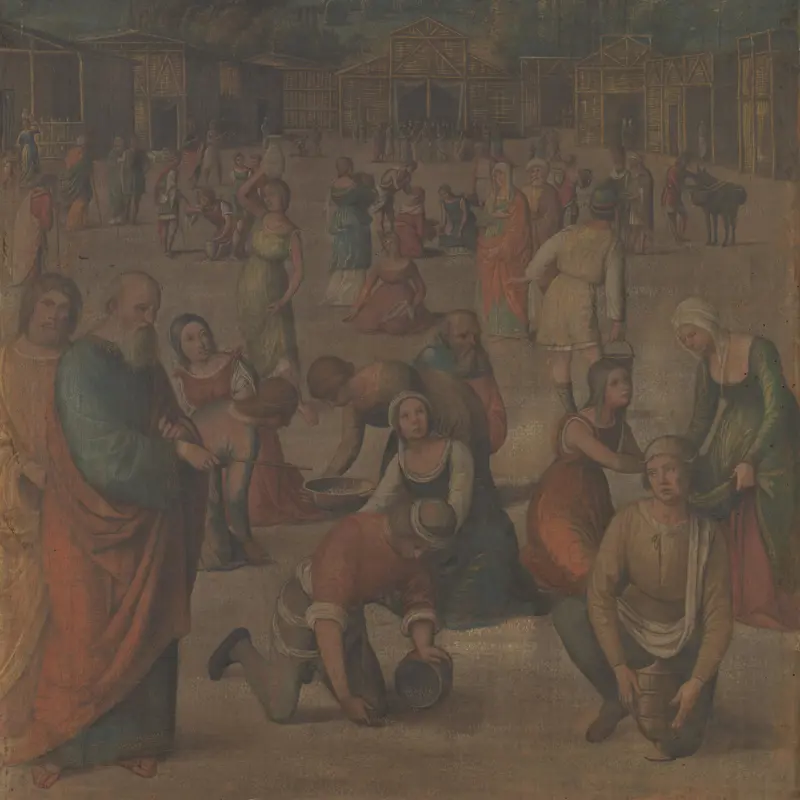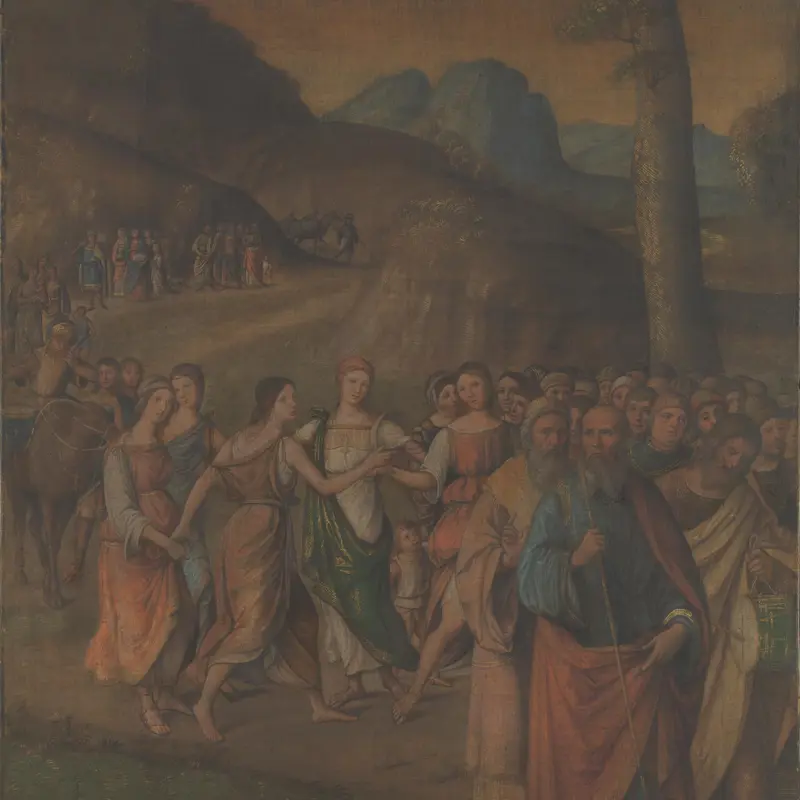Niccolò Pisano, 'The Israelites gathering Manna', probably 1500-3
About the work
Overview
According to the Book of Exodus, the Israelites, having escaped slavery in Egypt, feared famine as they wandered the desert. They complained to Moses, so God sent down a heavenly food, manna, which fell from the sky each morning but melted in the sun. Here, they gather the manna up into pots, jars, bowls and even pinafores.
This painting on linen canvas – a rare survival from the Renaissance – was probably originally in a small chapel or oratory in Ferrara, or possibly in the house of one of the Jewish community there. It is one of a group of eight similar paintings showing subjects from Genesis and Exodus, two of which are in the National Gallery’s collection.
Given the fragility of painting on linen, both this and The Dance of Miriam are in reasonable condition, although they were probably originally brighter: both are covered with surface dirt and some of the pigments have deteriorated. A distinctive feature of both is the copious amount of finely applied gilding, which would have shone by candle light.
Key facts
Details
- Full title
- The Israelites gathering Manna
- Artist
- Niccolò Pisano
- Artist dates
- 1470 - about 1536
- Part of the series
- Two Scenes from the Story of Moses
- Date made
- Probably 1500-3
- Medium and support
- Glue tempera on canvas (linen)
- Dimensions
- 119.3 × 78.7 cm
- Acquisition credit
- Layard Bequest, 1916
- Inventory number
- NG3103
- Location
- Not on display
- Collection
- Main Collection
- Previous owners
Provenance
Additional information
Text extracted from the ‘Provenance’ section of the catalogue entry in Giorgia Mancini and Nicholas Penny, ‘National Gallery Catalogues: The Sixteenth Century Italian Paintings’, vol. 3, ‘Bologna and Ferrara’, London 2016; for further information, see the full catalogue entry.
Bibliography
-
1838C. Laderchi, Descrizione della quadreria Costabili, 4 parts, Ferrara 1838
-
1844G. Baruffaldi, Vite de' pittori e scultori Ferraresi, ed. G. Boschini, Ferrara 1844
-
1857C. D'Arco, Delle arti e degli artefici di Mantova, Mantua 1857
-
1892G. Morelli, Italian Painters: Critical Studies of Their Works, 2 vols, London 1892
-
1895G. Lafenestre and E. Richtenberger, Venise, Paris 1895
-
1896G. Frizzoni, 'La Galerie Layard', Gazette des beaux-arts, II, 1896, pp. 455-76
-
1897G. Gruyer, L'art ferrarais à l'époque des princes d'Este, Paris 1897
-
1901A. Venturi, Storia dell'arte italiana, 11 vols, Milan 1901
-
1903A. Venturi, 'Maestri ferraresi del Rinascimento', L'arte, 1903
-
1907B. Berenson, North Italian Painters of the Renaissance, New York 1907
-
1912J.A. Crowe and G.B. Cavalcaselle, A History of Painting in North Italy: Venice, Padua, Vicenza, Verona, Ferrara, Milan, Friuli, Brescia, from the Fourteenth to the Sixteenth Century, ed. T. Borenius, 2nd edn, 3 vols, London 1912
-
1913A. Luzio, La galleria dei Gonzaga venduta all'Inghilterra nel 1627-28: Documenti degli archivi di Mantova e Londra, Milan 1913
-
1920C. Gamba, 'La raccolta Visconti Venosta', Dedalo, I/2, 1920
-
1957A. Puerari, Boccaccio Boccaccino, Milan 1957
-
1962Gould, Cecil, National Gallery Catalogues: The Sixteenth Century Italian Schools (excluding the Venetian), London 1962
-
1967R. Varese, Lorenzo Costa, Milan 1967
-
1968R. Longhi, Ampliamento nell'Officina ferrarese, Rome 1968
-
1975C. Gould, Delaroche and Gautier: Gautier's Views on the 'Execution of Lady Jane Grey' and on other Compositions by Delaroche, London 1975
-
1977L. Benini, 'Descrizione della quadreria Costabili', Musei ferraresi: bollettino annuale, VII, 1977, pp. 79-96
-
1977P. Tosetti, 'Lorenzo Costa', University of Padua: Annals of the Faculty of Arts and Philiosophy, II, 1977
-
1985C.T. Dowd, 'The Travel Diary of Otto Mündler', The Walpole Society, LI, 1985
-
1985E. Sambo, I Campi e la cultura artistica cremonese del Cinquecento (exh. cat. Santa Maria della Civilta, Santa Maria della Pietà, Vecchio Ospedale and Sala Manfredini, Museo Civico, 27 April - 28 July 1985), Milan 1985
-
1985M. Gregori, 'Alessandro Pampurino', in I Campi e la cultura artistica cremonese del Cinquecento, Milan 1985
-
1986F. Zeri and F. Rossi, La raccolta Morelli nell'accademia Carrara, Milan 1986
-
1986M. Tanzi, 'Risarcimento dell'Aleni: Verifiche in margine ad una mostra', Bollettino d'arte, CXXI, 1986, pp. 75-94
-
1987Gould, Cecil, National Gallery Catalogues: The Sixteenth Century Italian Schools, London 1987
-
1988E. Sambo, 'Niccolò Pisano tra Ferrara e Bologna', Paragone, XXXIX/455, 1988
-
1990A. Ugolini, 'Rivedendo la Collezione Costabili di Ferrara', Paragone, XLI/489, 1990, pp. 50‑76
-
1991A. Pattanaro, 'La "scuola" del Boccaccino a Ferrara', Prospettiva, LXIV, 1991, pp. 60-74
-
1993J. Anderson, 'Documents for the History of Collecting: 16: The Rediscovery of Ferrarese Renaissance Painting in the Risorgimento', The Burlington Magazine, CXXXV/1085, 1993, pp. 539-49
-
1994M. Eidelberg, 'The Dispersal of the Last Duke of Mantua's Paintings', Gazette des beaux-arts, CXXXVI/123, 1994, pp. 207-94
-
1995A. Ballarin, Dosso Dossi: La pittura a Ferrara negli anni del Ducato di Alfonso I, Padua 1995
-
2001
C. Baker and T. Henry, The National Gallery: Complete Illustrated Catalogue, London 2001
-
2016Mancini, Giorgia, and Nicholas Penny, National Gallery Catalogues: The Sixteenth Century Italian Paintings, 3, Bologna and Ferrara, London 2016
About this record
If you know more about this work or have spotted an error, please contact us. Please note that exhibition histories are listed from 2009 onwards. Bibliographies may not be complete; more comprehensive information is available in the National Gallery Library.
Images
About the series: Two Scenes from the Story of Moses

Overview
These two Old Testament scenes are painted not on panel, as are most surviving Italian Renaissance paintings, but on linen. They are part of a series of eight paintings on linen canvasses by various artists, which survive in various collections.
Although now rare, paintings on linen were widespread in the Renaissance. They could serve as hangings, curtains, altar frontals and banners, as well as framed works of art; they were much cheaper than tapestries, faster to execute than frescoes and easier to transport than panel paintings.
These pictures probably came from a small chapel or oratory in Ferrara. Alternatively, they might have been from the home of a member of Ferrara’s Jewish community.


